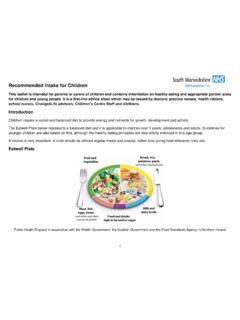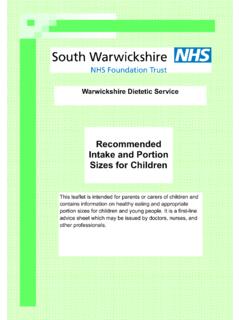Transcription of Dietary Advice for Polycystic Ovary Syndrome (PCOS)
1 Warwickshire Dietetic Service Dietary Advice for Polycystic Ovary Syndrome (PCOS). This leaflet explains what PCOS is, and gives information on the benefits of a healthy diet and lifestyle, including weight loss and glycaemic index. It also gives information on how to make the changes needed. Dietary Advice for Polycystic Ovary Syndrome The exact cause of PCOS is unknown. Many symptoms are caused by insulin resistance. The main symptoms include: Absent, infrequent or irregular periods Excess hair (hirsutism) particularly on your face, chest and stomach Difficulty controlling weight Thinning of hair Acne Infertility (problems conceiving). Tiredness Mood swings Raised cholesterol Under or over active thyroid Low self-esteem Depression. Long-term risks Having PCOS can increase your risk of developing Type 2 diabetes and heart disease.
2 Treatment There is currently no cure for PCOS, however, its symptoms may be improved by Dietary and lifestyle changes, healthy eating, increased physical activity, cosmetic measures and medication. Stopping smoking is also encouraged as part of a healthy lifestyle. Evidence has shown that these Dietary and lifestyle changes are the most effective treatment for PCOS. What is insulin? Insulin is a hormone made by the pancreas (an organ in the body) which helps take the glucose (sugar) in the blood to the cells to produce energy, so we can carry out the normal activities of daily living. What is insulin resistance? Insulin resistance occurs when the body is producing insulin, but it is not working effectively so the glucose cannot be used by the cells. The body then produces more insulin to compensate for this which causes high insulin levels in the blood.
3 Unfortunately high insulin levels favour weight gain and an increase in testosterone production. The diagram below shows the cycle of weight gain with insulin resistance: Insulin resistance Pancreas makes more insulin Increased fat storage promoting weight gain Raised testosterone causing acne, hirsutism, irregular periods, absent periods and infertility. Page 2. Dietary Advice for Polycystic Ovary Syndrome Difficulty controlling weight? Some women with PCOS find it difficult to lose weight due to the effects of high insulin levels. Body weight represents the balance between energy intake from Dietary sources and energy expenditure through daily living. To enable weight loss, the energy you use must be greater than the energy (calories) you take in as food. This can be achieved by changing your diet and lifestyle in a way that is easy for you.
4 Benefits of weight loss It has been shown that a 5% weight loss can lower insulin levels which can improve periods, reduce hirsutism, reduce acne and can increase the chances of conceiving if you are trying to get pregnant. Body Mass Index (BMI). BMI is used as a guide to measure if an individual is of a healthy weight, underweight or overweight. It is calculated by: Weight (kg) 16-19 = underweight Height (m2) 20-25 = healthy weight 26-30 = overweight 31-40 = obese Your BMI today is .. Initial 5% weight loss target will be .. Some hints for losing weight Do not try crash diets. These do not work in the long-term and you will benefit more from making life-long permanent healthier alterations to your diet. Set realistic, achievable targets; aim to lose no more than (1-2 lbs) per week. Make healthier changes to your diet.
5 Avoid foods which are high in fat and sugar as these foods are high in calories. Fill up on fruit and vegetables. Consider keeping a food diary to record your intake. Make healthier changes with friends and/or family for additional support. Try to keep motivated and focused. Hints for a healthy balanced diet Food is an important part of our lives not only does it provide us with energy, it gives us the nutrients, vitamins and minerals which our bodies need to function properly. No single food contains these nutrients, so a mixture of foods should be eaten. Page 3. Dietary Advice for Polycystic Ovary Syndrome Eight principles of healthy eating: 1. Enjoy your food. 2. Eat a variety of different foods. 3. Control your portion sizes (ask your Dietitian for further Advice ). 4. Eat sensible amounts of carbohydrates and choose higher fibre varieties.
6 5. Eat plenty of fruit and vegetables. 6. Do not eat too many foods that contain a lot of fat and sugar. 7. Drink plenty of fluids. If you drink alcohol, drink sensibly. 8. Do not skip meals. The Eatwell Plate The Eatwell Plate is a visual aid showing us the types and proportions of different foods which make up a healthy diet. Bread, rice, potatoes, pasta and other starchy foods This food group is an essential source of carbohydrate, and provides us with energy and helps fill us up. It also provides us with fibre, B vitamins, iron and zinc. Although some starchy carbohydrates are recommended with each meal it is very important to control your portion sizes. Your Dietitian can individually advise you on recommended amounts of carbohydrates to eat. A portion is: 2-3 egg-size new potatoes 1 medium baked potato (with skin).
7 1 medium slice of bread 30g breakfast cereal (3 tablespoons). 1 Weetabix Page 4. Dietary Advice for Polycystic Ovary Syndrome Fruit and vegetables Aim to have at least five portions of fresh, frozen, tinned, dried or juiced fruit and vegetables every day. Try to eat a variety of fruit and vegetables as they all contain different essential vitamins, minerals and antioxidants and add colour, taste, texture and variety to your diet. Fruit and vegetables provide a healthy snack between meals. A portion is: A small glass of fruit juice (150 ml). 1 medium sized piece of fruit, banana, apple, orange, pear 2 small fruits, kiwi, plum, apricot A small handful of grapes, cherry tomatoes 2-3 heaped tablespoons of cooked vegetables 1 bowl of salad 1 slice of large fruit, melon, pineapple. Please note: fruit juice counts as only one portion regardless of how much you drink and potatoes do not count towards the recommended five portions.
8 Milk and dairy foods Dairy products provide a good source of calcium. You should aim to have 2-3 portions every day. A portion is: 200 ml milk 150g yoghurt/fromage frais (small pot). 40g cheese (small matchbox size). 200g cottage cheese (large pot). For a healthy, balanced diet try lower fat varieties: Use skimmed, 1% or semi-skimmed milk instead of full cream milk . Use low fat cheeses, cottage cheese, Edam, half-fat cheddar. Try grating cheese instead of using slices. Try low fat yoghurts. Meat, fish, eggs and beans This food group is essential for providing protein and minerals such as iron. You should aim for 2- 3 portions daily. A portion is: 4 oz (112g) fish 3 oz (84g) meat 3 thin slices of lean meat 2 eggs 2 tablespoons of nuts 4-5 tablespoons of lentils/beans. Tips Avoid roasting or frying in large amounts of oil or fat.
9 Try to use healthy cooking methods including baking, grilling, microwaving, boiling and steaming foods. Choose lean meat. Remove visible fat and skins from meat and poultry. Try to include one portion of oily fish (sardines, herring, kippers, pilchards, salmon, mackerel) a week. Dietary Advice for Polycystic Ovary Syndrome Foods and drinks high in fat and/or sugar Foods containing fat are high in calories, and foods high in sugar will cause sharp rises in your blood sugar levels. Therefore they should both be limited. Tips Use lower fat dairy products. Choose healthier cooking methods. Try using sweeteners instead of sugar in drinks and on cereals. Choose low calorie, sugar free or no added sugar drinks. Only eat sweets, puddings, cakes, chocolate, takeaways, pies and pastries occasionally. Alcohol Alcohol is high in calories and should be kept within sensible limits.
10 Current recommendations are no more than 14 units a week for women. For women who do drink as much as 14 units per week, this is best spread out evenly over three days or more. A unit of alcohol will vary according to the strength, but is approximately: pint (300 ml) of beer, bitter, lager or cider a pub measure (25 ml) of spirits such as gin, vodka, whisky or rum a small glass (125 ml) of wine. Confused by food labels? Reading food labels is a good way to find out how much fat and sugar is in pre-packaged food. The two most important things to look out for are fat and sugar. It is best to look at the per 100 g column because the portion sizes of foods tend to differ. This will make it difficult to compare products. Using the per 100 g column will give a percentage of the amount of fat and sugar in the product. Guide to food labelling (per 100 g).






